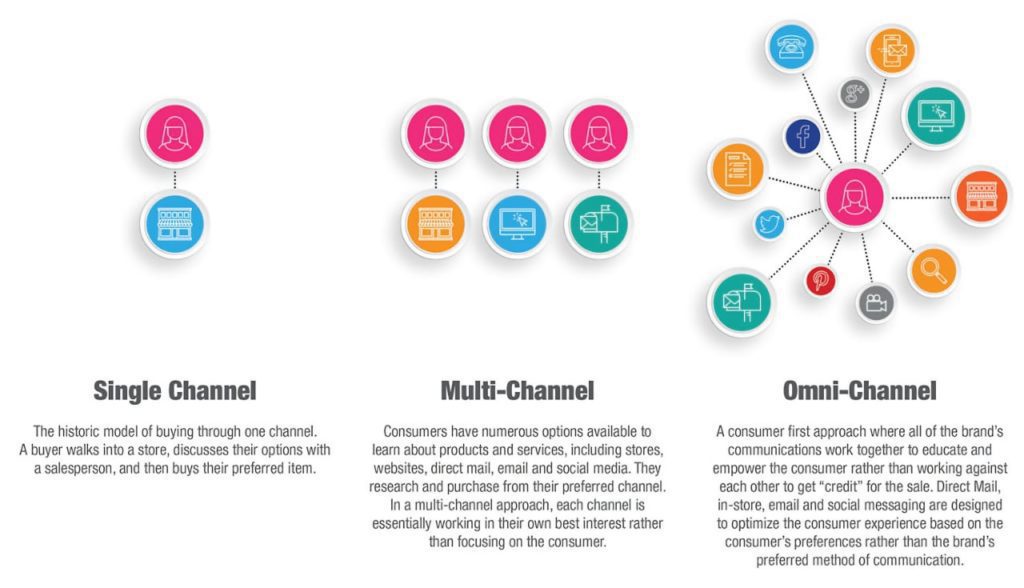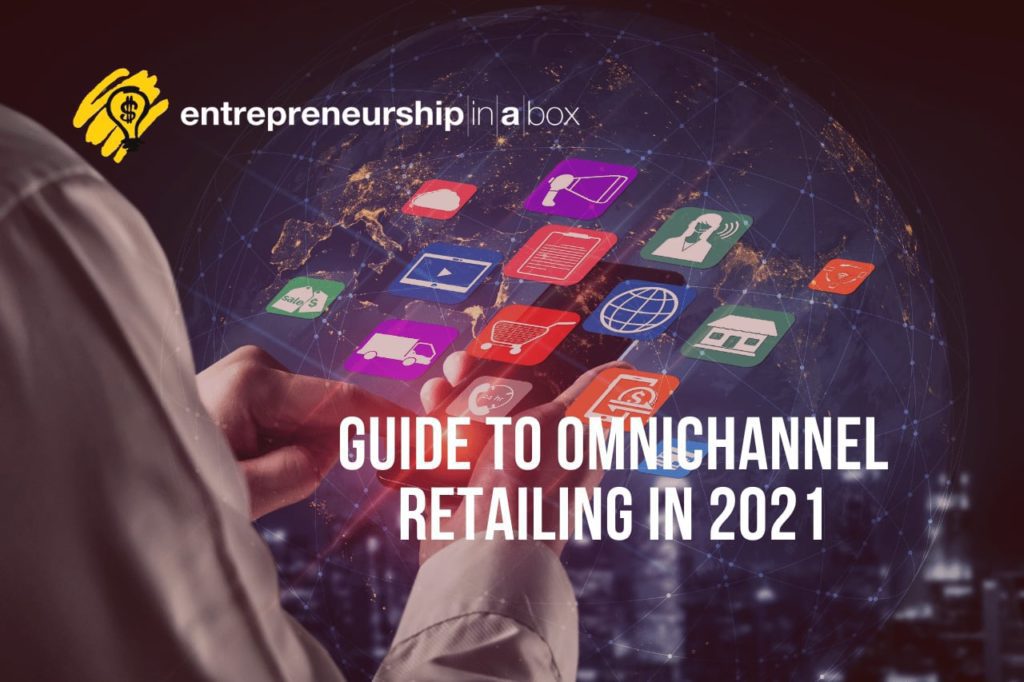In the last several years we saw an explosion in digital selling. Retailers are moving toward omnichannel, and this means they’ll need to be ready to handle customers from different channels in real-time.
As a pandemic swept the globe, almost every sector saw a shift to digital. It was the year that screen time replaced face time and B2B and B2C sellers realized that an omnichannel experience is now the baseline for buyers. It’s as expected as a brand website.
According to the MasterCard Economic Institute, the outlook for 2021 shows that 20% – 30% of the shift to eCommerce during the pandemic will become permanent. No matter what your company sells or to whom they sell it, omni channel retailing cannot be ignored.
In this article, we explore the different elements that go into omnichannel retailing and offer some ideas on how you can use them to improve your customer experience.
Table of contents
What is Omnichannel Retailing?
Omnichannel retailing is the fusion of digital selling with your physical selling channels. It doesn’t put priority over one channel, it brings all channels together. Because that’s the way today’s modern buyer interacts with products and brands.
For example, a shopper may see a photo of a product on Instagram using their tablet. Later, on their phone, they see an ad for the product on Facebook. Then they follow the ad link to the online store. They may or may not make a purchase. But when they visit the physical store, their app can push an alert about products in which they are interested. Or in another case, a buyer may search for a product on their desktop and then go to a store to view the product. The purchase can be completed in person or they may go back to the desktop, look for a coupon code and finalize the sale. They might even buy on-line with their cell phone while still in the store.
Omnichannel retailing recognizes that today’s buyers may interact with brands in person, on the phone, or digitally through websites, social media, or email. It’s a cohesive approach to the meeting and marketing to a buyer when and where they want.
Omnichannel versus Multichannel
By now you are thinking, is this just a new name for multi-channel marketing? Nope. Multichannel and omnichannel marketing is very different.

With a multichannel approach, each channel is distinct. The store is separate from the eCommerce website, which is different from the print catalog, or email marketing campaigns. Each channel is individually focused on the customer. While that focus on the customer isn’t a bad thing, it is fractured. And that’s not how customers see your brand. No matter how they are interacting, they still see the XYZ Widget Company the same, whether online or in person. Omnichannel personalizes the experience to the desires of the customer. The customer is still the focus, but instead of each channel competing they work in unison.
As physical locations evolve to address the needs of today’s digital shoppers, an omnichannel experience is more important than ever.
Related: How to Have Multiple Phone Numbers on One Cell Phone: A Step-By-Step Guide
Omnichannel Uses Digital Experiences to Support Physical Locations
As COVID-19 forced buyers out of stores and onto their phones, laptops, and tablets retailers had to rethink physical locations.
Now, square footage is downsized, and physical locations are more than spaces for shopping. They can serve as hubs for buy-online pickup-in store (BOPIS) models or even operate as local fulfillment centers for online orders.
People still want to explore and discover new products. Now they start that journey digitally, perhaps even through social media, and then continue the exploration in person at a store with minimal contact.
Physical locations won’t disappear, but they will evolve. And omnichannel retailing is what will support the evolution.
What to Include in Your Omnichannel Strategy
Your omnichannel strategy should provide a cohesive approach that connects your physical and digital presence, support multiple business models, and improves the customer experience.
Connecting the digital and physical
It’s important that your physical and digital presence is unified. Social media, stores, and web stores should use consistent product descriptions and reviews. Pricing should be consistent as well. While you may offer digital-only options (such as specific colors or finishes) in general what you see online should be what you see in a store. Don’t confuse your customers with conflicting information. A product information management tool (PIM) may come in handy.
Integrating your eCommerce website with your ERP and WMS will provide customers visibility into product supply by location. Reconcile to account for loss and breakage regularly to ensure that what you show in stock at a location is what is available at that location.
Support multiple business models
More and more manufacturers, wholesalers, and distributors are opening B2C and D2C channels. If you are a B2B seller looking to move into these retail spaces, you need to plan for serving both customer segments with your omnichannel strategy.
Make sure your apps, websites, and social media are as prepared to serve retail customers as your sales staff. Grainger was one of the first major B2B sellers to understand the importance of B2C customers. Whether you are a retail customer walking in to purchase a roll of electrical tape or a business customer that needs 2 cases of electrical tape shipped to a dispatching unit, Grainger provides a personalized experience online and in person.
Brand consistency is key
The goal here is to provide a consistent experience across all channels. No matter the touchpoint, the brand voice, and message must be the same. Nothing is more off-putting to a customer than a brand suffering from schizophrenia. Customers should immediately recognize the brand and message as yours. Not all customers will interact using all channels. But, for customers using more than one channel, the experience should be the same. So, don’t have an app and social media presence that focuses on product price when your website and store message is centered on quality-based messages.
Share data to improve and personalize the customer experience
When you link apps, eCommerce, CRM, and ERP you can provide each customer a highly personalized shopping experience.
Track wish list items and send push notifications when the customer is in the store. On digital channels, serve up related product suggestions and advise on inventory levels. If a shopper is in a store and has an abandoned eCommerce shopping cart, this is the perfect time to remind them to complete the purchase.
Integrate your business systems so data flows throughout and then use that data to improve and personalize the customer experience. The right data combined with powerful analytics tools allows you to identify customer needs and then act on them when the time is right.
Frequently Asked Questions
Omnichannel retailing is a term that refers to the idea of the retail business merging different online and offline channels. So, generally speaking, it means retailers are using every channel they can to reach and engage with customers. They’re using email to communicate with customers, offering products on the web, mobile apps, and physical stores. Also, they are using social media to engage with customers and offering discounts to encourage shoppers to purchase in stores.
While the concept of omnichannel retailing has been around for quite some time, its current popularity can likely be attributed to a few significant trends: 1) mobile technology has become a part of everyday life, enabling consumers to complete transactions anywhere and anytime; 2) social media has become a crucial part of our lives, giving people a platform to interact with brands and brands have responded by building highly responsive apps and websites to meet their customers wherever they are and whatever device they are using, 3) consumers are increasingly mobile, driving the need for a seamless, cross channel shopping experience.
Omnichannel retailers must offer seamless and personalized experiences across channels and a consistent brand experience regardless of channel. To succeed, they need to understand and analyze the data they collect. Then, they need to build a plan to connect all the different systems within the company, including those outside the company. An omnichannel strategy has to focus on making sure customers can find and interact with retailers in ways that are easy to access, whether they’re at home, on the road, or on their mobile devices.
Conclusion
In conclusion, the idea behind omnichannel retailing is that your customers shop online, in stores, and via mobile and social channels. You must offer the same or similar experiences across all these channels. So it is crucial to understand omnichannel retailing and the various ways it can be implemented. This can be a significant change for some brands and retailers, as they currently might only consider a single channel or method of communication. We believe it’s essential to understand omnichannel retailing to ensure you’re designing your digital strategy appropriately.



